Hey urban planners in OZ!… Do you want some challenges that are a bit different from managing growth? Well check out what’s happening in New Zealand.
For very different reasons, planners in the two largest cities in New Zealand (Auckland and Christchurch) have had to produce comprehensive strategic plans – in no time flat.

Fast Planning in Auckland
Only two years ago the ‘Supercity’ of Auckland was created by amalgamating seven local authorities in the Auckland region into one. The biggest challenge for planners in the new Auckland Council has been to produce a comprehensive Draft Auckland Plan within two years of amalgamation. The impetus to get the plan up so quickly was largely driven by the fact that Auckland is pivotal for the New Zealand economy. As the Plan states, “The city centre is the heart of the Auckland region and it’s economically vital to both Auckland and the country…”.
While the new strategy for Auckland explicitly includes an overarching Strategic Plan; an Economic Development Strategy; a City Centre Master Plan; and a Waterfront Plan, it seems that one of the key drivers behind the amalgamation and the subsequent strategic planning is to build a transport system that works for New Zealand’s premier economic urban node.
Countries need urban nodes that can compete, if not globally, then at least regionally – and for New Zealand, Auckland is it! The importance of Auckland to New Zealand’s national economy is undeniable, and global/regional urban nodes cannot grow and prosper if people and goods can’t get around – a comprehensive and effective transport system is vital to achieving this.
Impressively, the planners met their deadline and you can view the Draft Auckland Plan here.
Fast Planning in Christchurch
In August 2011 Christchurch planners published the Draft Central City Plan – a mere 6 months after the February 2011 earthquake. That is an awesome achievement of fast planning – and no doubt dealing with disaster provides an incentive to get things done.
It is generally accepted that the urban centres of metropolitan areas are the social and economic hearts of not just the greater city but also the region in which they operate. Given that less than one year ago, the CBD of Christchurch was literally demolished by an earthquake – the impact of the earthquake on the whole Canterbury Region is both socially and economically profound.

The requirement to redevelop a city centre almost from scratch does provide the community and its planners with a unique opportunity to do something really exceptional for Christchurch. Exciting as that opportunity may seem, it is being done under the shadow of a very recent disaster resulting in both loss of life and loss of a place – city scapes form an important ‘life history/sense of place’ visual records for people – which in itself presents an interesting challenge for the planners.
Nevertheless in a very short time frame, the Christchurch planners have had to take on the challenge of developing a draft plan to rebuild a place that the community has a deep affection for and connection with. The plan therefore needs to acknowledge and respect the past, while also making the most of the rare opportunity to address problems identified from the past without the physical constraints existing anymore. There are things from the past such as the grid pattern of streets that are well worth keeping and enhancing, while the future CBD will be much more compact and will incorporate more green spaces.
Planning for the future of Christchurch has also had to take into account the changed perception about the threat of earthquake – from one of being on a secondary fault line that nobody thought would experience a quake let alone such devastation, to a place which is planning to build a low rise city centre that is effectively earthquake resistant. This new urban form for the city centre has a range of economic and aesthetic advantages beyond just being earthquake proof, which are clearly outlined in the Draft Plan. You can view it here.
Fast Planning in general
Fast planning can be very effective because communities can become jaded with the cycle of ongoing studies and revisions resulting in the on-again/off-again promises for the delivery of infrastructure. Slow planning loses the engagement of the community.
I have looked at plans for many cities over the years and there are rarely any completely new ideas in them. This in itself is not a problem. What is important is that strategic planners are aware of all these ideas for cities; that they have the means to question established assumptions and; that they work out how best to apply strategic solutions to the unique urban problems that exist in their cities. It seems that by selecting, adapting and applying existing ideas for cities has enabled the planners of Auckland and Christchurch to come up with quality draft plans for their cities – fast.
.id is a team of demographers, population forecasters, spatial planners, urban economists, and data experts who use a unique combination of online tools and consulting to help governments and organisations understand their local areas. Access our free demographic resources here











